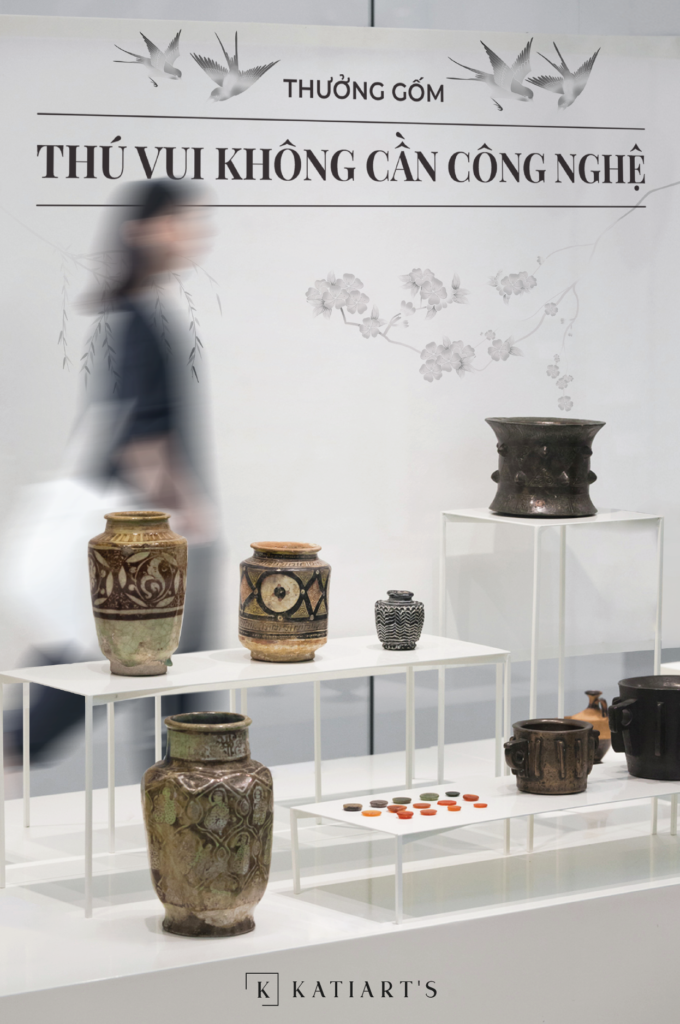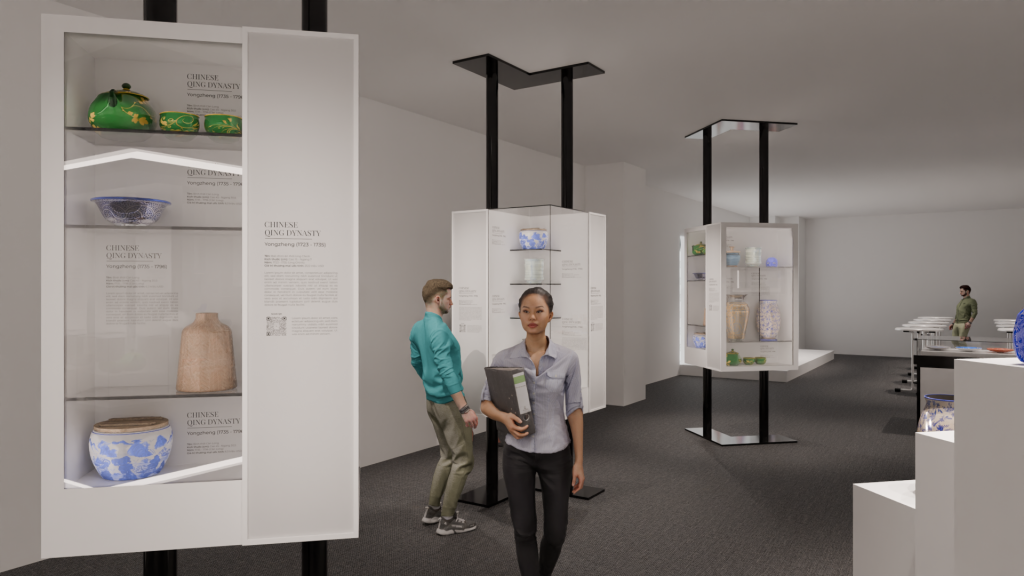
Ceramic appreciation – A long-standing traditional cultural pastime, is a refined pleasure enjoyed by monarchs and ancient scholars, preserved and developed to this day. Have you ever spent an hour, a night, or a day just to admire a ceramic vase? If not, let Katiart’s guide you on a journey of ceramic enthusiasts to broaden your perspective on the art of ceramic appreciation!
I. The Hidden Beauty of the Era in Every Intricate Pattern

a. The Hidden Beauty of Ceramics
Each ceramic vase is not merely a decorative item but a work of art that, when observed, reveals the artisan’s talent through intricate patterns and harmonious colors. This not only attracts art lovers but also young people seeking uniqueness and distinction.
b. A Journey Connecting History and Contemporary Culture
An ancient ceramic vase captivates not only with its external beauty but also with its fascinating cultural and historical stories. Each line and pattern on the ceramics tells us about an era, a culture, or folklore. Imagine holding a witness of history or a piece of history in your hands, where every small detail carries its own meaning. It is a truly interesting and meaningful experience, isn’t it?
What is Katiart’s Mission? Why should readers know about Katiart’s Gallery?
II. What is Ceramic Appreciation?
Ceramic appreciation, one of the cultural and artistic activities that attract many people, especially art lovers. Ancient and contemporary artisans have crafted ceramic products with high artistic value while preserving the nation’s precious traditions. Ceramic appreciation is not only a unique art enjoyment activity but also an interesting experience for young people in the modern era.

III. The Origin of Ceramic Appreciation Culture
a. Originating from Ancient China:
The culture of ceramic appreciation has deep roots in ancient China, where ceramic art flourished from the Neolithic period. During the Shang (1600-1046 BCE) and Zhou (1046-256 BCE) dynasties, ceramics began to be crafted with sophistication and diversity in designs. However, it was not until the Han Dynasty (206 BCE – 220 CE) that the culture of ceramic appreciation truly formed and developed. Han ceramics were not only daily utensils but also artistic works with spiritual and cultural value. The royal family and nobility often collected ceramic products as symbols of prosperity and power.
b. Development during the Tang – Song Dynasties:
During the Tang (618-907) and Song (960-1279) dynasties, the culture of ceramic appreciation entered its golden age. This period witnessed the emergence of many famous ceramic lines such as Jingdezhen and Longquan ceramics. Emperors and officials often organized ceramic appreciation parties, where exquisite ceramic vases were presented and meticulously evaluated. This was not only a recreational activity but also a way for officials to demonstrate their understanding and aesthetic taste.

c. Ceramic Appreciation in Japanese Culture:
The culture of ceramic appreciation not only developed in China but also spread to Japan, where it was integrated with the tea ceremony during the Muromachi period (1336-1573). In Japan, ceramic appreciation became an important part of the tea ceremony, where ceramic tea bowls were considered the soul of the ceremony. Japanese artisans developed special ceramic lines such as Raku and Shino, characterized by their natural and delicate beauty. The culture of ceramic appreciation in Japan is not only about evaluating the beauty of a tea bowl but also honoring the philosophy of simple and serene living.
d. Spread to the West:
In the 16th-17th centuries, through East-West trade routes, Chinese and Japanese ceramics began to enter Europe, where the culture of ceramic appreciation quickly became popular among the nobility and royalty. Eastern ceramic products were not only collected but also became symbols of luxury and prosperity. Many European ceramic factories, such as Meissen in Germany and Sèvres in France, were established to meet the growing market demand. Ceramic appreciation became an indispensable part of European aristocratic culture.
Who is Katiart’s and what is our mission?
IV. The Art of Ceramic Appreciation is the Subtlety in Every Moment
a. Ceramic Appreciation in Tea Culture
Tea culture and ceramics always go hand in hand, where each tea bowl is not only a utensil but also a work of art. Exploring this combination can provide readers with deeper insights into the culture of appreciation, as well as the connection between these two art forms.
b. Where the Flow of Time Merges with Historical Paintings
When appreciating ceramics, you not only admire its beauty but also connect with the past. An ancient ceramic vase can make you feel like you are embarking on a journey through time, where you can discover interesting things about ancient people and their lives. This is not only a way to understand history better but also helps us appreciate the cultural values passed down through generations.

c. Finding Peace in the Soul
Modern life often makes us busy and stressed. Ceramic appreciation can be a great way to slow down, find balance, and peace in the soul. When looking at a ceramic vase, you can easily be captivated by its harmony, helping your mind to be calm and relaxed. This is an interesting way to practice patience and focus, something we sometimes easily forget in a pressure-filled life.
d. The Pleasure of “Touching with the Eyes” for Art Lovers
An experience that only art enthusiasts, especially ceramic lovers, can have is the art of “touching with the eyes.” When you gaze at a ceramic vase for a long time, you will feel the patterns on it as if they are moving, the dragon as if it is flying, the flower as if it is swaying, creating a unique film for each person.
V. Ceramic Appreciation in Modern Life
a. Modern Interior Decoration Trends with Ceramics
Research how ceramics are used in modern interior decoration, from minimalist spaces to traditional designs, helping readers understand the role of ceramics in creating aesthetic and emotional living spaces.
b. The Revival of Ceramics in Contemporary Art
Ceramics have become an endless source of inspiration for modern artists and designers, opening up new directions in art and design. The combination of tradition and innovation in modern ceramics is a fascinating topic worth exploring.
VI. Conclusion:
Ceramic appreciation is not only a pleasure but also a journey of self-discovery and cultural connection. For young people, this can be a novel way to learn about art and culture, as well as to develop aesthetic taste and creativity. Ceramic appreciation offers us the opportunity to view life from a different, deeper, and more meaningful perspective.

Museums & art galleries around the world are places to preserve and display precious Chinese antiques:
- Katiart’s Gallery – Vietnam
- National Palace Museum – Taipei
- The Metropolitan Museum of Art – New York
- Victoria and Albert Museum (V&A) – London
- Musée Guimet – Paris
The exhibition “Katiart’s – The Essence of Ceramics” is a journey through history, honoring the essence of traditional craftsmanship, from ancient times to the modern era. The displayed works not only carry material value but also embody the culture and soul of humanity through the ages. The exhibition is not only a place to admire the beauty of creations but also a bridge to the past, preserving the mysteries and exquisite techniques passed down through generations.
Related Articles:
